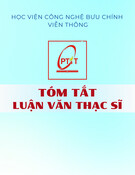
Annals of Mathematics
Sum rules for Jacobi matrices
and their applications to spectral
theory
By Rowan Killip and Barry Simon*

Annals of Mathematics, 158 (2003), 253–321
Sum rules for Jacobi matrices
and their applications to spectral theory
By Rowan Killip and Barry Simon*
Abstract
We discuss the proof of and systematic application of Case’s sum rules
for Jacobi matrices. Of special interest is a linear combination of two of his
sum rules which has strictly positive terms. Among our results are a complete
classification of the spectral measures of all Jacobi matrices Jfor which J−J0
is Hilbert-Schmidt, and a proof of Nevai’s conjecture that the Szeg˝o condition
holds if J−J0is trace class.
1. Introduction
In this paper, we will look at the spectral theory of Jacobi matrices, that
is, infinite tridiagonal matrices,
(1.1) J=
b1a100···
a1b2a20···
0a2b3a3···
.
.
..
.
..
.
..
.
....
with aj>0 and bj∈
R
.Wesuppose that the entries of Jare bounded, that is,
supn|an|+ supn|bn|<∞so that Jdefines a bounded self-adjoint operator on
ℓ2(
Z
+)=ℓ2({1,2,...}). Let δjbe the obvious vector in ℓ2(
Z
+), that is, with
components δjn which are 1 if n=jand 0 if n=j.
The spectral measure we associate to Jis the one given by the spectral
theorem for the vector δ1. That is, the measure µdefined by
(1.2) mµ(E)≡δ1,(J−E)−1δ1=dµ(x)
x−E.
∗The first named author was supported in part by NSF grant DMS-9729992. The second named
author was supported in part by NSF grant DMS-9707661.

254 ROWA N KILLIP AND BARRY SIMON
There is a one-to-one correspondence between bounded Jacobi matrices
and unit measures whose support is both compact and contains an infinite
number of points. As we have described, one goes from Jto µby the spectral
theorem. One way to find J, given µ,isvia orthogonal polynomials. Apply-
ing the Gram-Schmidt process to {xn}∞
n=0, one gets orthonormal polynomials
Pn(x)=κnxn+···with κn>0 and
(1.3) Pn(x)Pm(x)dµ(x)=δnm.
These polynomials obey a three-term recurrence:
(1.4) xPn(x)=an+1Pn+1(x)+bn+1Pn(x)+anPn−1(x),
where an,b
nare the Jacobi matrix coefficients of the Jacobi matrix with spec-
tral measure µ(and P−1≡0).
The more usual convention in the orthogonal polynomial literature is to
start numbering of {an}and {bn}with n=0and then to have (1.4) with
(an,b
n,a
n−1) instead of (an+1,b
n+1,a
n). We made our choice to start num-
bering of Jat n=1so that we could have znfor the free Jost function (well
known in the physics literature with z=eik) and yet arrange for the Jost
function to be regular at z=0. (Case’s Jost function in [6, 7] has a pole since
where we use u0below, he uses u−1because his numbering starts at n= 0.)
There is, in any event, a notational conundrum which we solved in a way that
we hope will not offend too many.
An alternate way of recovering Jfrom µis the continued fraction expan-
sion for the function mµ(z) near infinity,
(1.5) mµ(E)= 1
−E+b1−a2
1
−E+b2+···
.
Both methods for finding Jessentially go back to Stieltjes’ monumental
paper [57]. Three-term recurrence relations appeared earlier in the work of
Chebyshev and Markov but, of course, Stieltjes was the first to consider general
measures in this context. While [57] does not have the continued fraction
expansion given in (1.5), Stieltjes did discuss (1.5) elsewhere. Wall [62] calls
(1.5) a J-fraction and the fractions used in [57], he calls S-fractions. This has
been discussed in many places, for example, [24], [56].
That every Jcorresponds to a spectral measure is known in the orthog-
onal polynomial literature as Favard’s theorem (after Favard [15]). As noted,
it is a consequence for bounded Jof Hilbert’s spectral theorem for bounded
operators. This appears already in the Hellinger-Toeplitz encyclopedic arti-
cle [26]. Even for the general unbounded case, Stone’s book [58] noted this
consequence before Favard’s work.

SUM RULES FOR JACOBI MATRICES 255
Given the one-to-one correspondence between µ’s and J’s, it is natural to
ask how properties of one are reflected in the other. One is especially interested
in J’s “close” to the free matrix, J0with an=1and bn=0,that is,
(1.6) J0=
0100...
1010...
0101...
0010...
.
In the orthogonal polynomial literature, the free Jacobi matrix is taken
as 1
2of our J0since then the associated orthogonal polynomials are precisely
Chebyshev polynomials (of the second kind). As a result, the spectral measure
of our J0is supported by [−2,2] and the natural parametrization is E=2cos θ.
Here is one of our main results:
Theorem 1. Let Jbe a Jacobi matrix and µthe corresponding spectral
measure. The operator J−J0is Hilbert-Schmidt,that is,
(1.7) 2
n
(an−1)2+b2
n<∞
if and only if µhas the following four properties:
(0) (Blumenthal-Weyl Criterion) The support of µis [−2,2] ∪{E+
j}N+
j=1 ∪
{E−
j}N−
j=1 where N±are each zero,finite,or infinite,and E+
1>E
+
2>
··· >2and E−
1<E
−
2<··· <−2and if N±is infinite,then
limj→∞ E±
j=±2.
(1) (Quasi-Szeg˝o Condition) Let µac(E)=f(E)dE where µac is the Lebesgue
absolutely continuous component of µ. Then
(1.8) 2
−2
log[f(E)]4−E2dE > −∞.
(2) (Lieb-Thirring Bound)
(1.9)
N+
j=1 |E+
j−2|3/2+
N−
j=1 |E−
j+2|3/2<∞.
(3) (Normalization) dµ(E)=1.
Remarks. 1. Condition (0) is just a quantitative way of writing that the
essential spectrum of Jis the same as that of J0, viz. [−2,2], consistent with
the compactness of J−J0. This is, of course, Weyl’s invariance theorem [63],
[45]. Earlier, Blumenthal [5] proved something close to this in spirit for the
case of orthogonal polynomials.
2. Equation (1.9) is a Jacobi analog of a celebrated bound of Lieb and
Thirring [37], [38] for Schr¨odinger operators. That it holds if J−J0is Hilbert-
Schmidt has also been recently proven by Hundertmark-Simon [27], although

256 ROWA N KILLIP AND BARRY SIMON
we do not use the 3
2-bound of [27] below. We essentially reprove (1.9) if (1.7)
holds.
3. We call (1.8) the quasi-Szeg˝o condition to distinguish it from the Szeg˝o
condition,
(1.10) 2
−2
log[f(E)](4 −E2)−1/2dE > −∞.
This is stronger than (1.8) although the difference only matters if fvanishes
extremely rapidly at ±2. For example, like exp(−(2−|E|)−α) with 1
2≤α<3
2.
Such behavior actually occurs for certain Pollaczek polynomials [8].
4. It will often be useful to have a single sequence e1(J),e
2(J),...obtained
from the numbers E±
j∓2by reordering so e1(J)≥e2(J)≥···→0.
By property (1), for any Jwith J−J0Hilbert-Schmidt, the essential
support of the a.c. spectrum is [−2,2]. That is, µac gives positive weight to
any subset of [−2,2] with positive measure. This follows from (1.8) because
fcannot vanish on any such set. This observation is the Jacobi matrix ana-
logue of recent results which show that (continuous and discrete) Schr¨odinger
operators with potentials V∈Lp,p≤2, or |V(x)|
.
(1 + x2)−α/2,α>1/2,
have a.c. spectrum. (It is known that the a.c. spectrum can disappear once
p>2orα≤1/2.) Research in this direction began with Kiselev [29] and cul-
minated in the work of Christ-Kiselev [11], Remling [47], Deift-Killip [13], and
Killip [28]. Especially relevant here is the work of Deift-Killip who used sum
rules for finite range perturbations to obtain an a priori estimate. Our work
differs from theirs (and the follow-up papers of Molchanov-Novitskii-Vainberg
[40] and Laptev-Naboko-Safronov [36]) in two critical ways: we deal with the
half-line sum rules so the eigenvalues are the ones for the problem of interest
and we show that the sum rules still hold in the limit. These developments are
particularly important for the converse direction (i.e., if µobeys (0–3) then
J−J0is Hilbert-Schmidt).
In Theorem 1, the only restriction on the singular part of µon [−2,2]
is in terms of its total mass. Given any singular measure µsing supported on
[−2,2] with total mass less than one, there is a Jacobi matrix Jobeying (1.7)
for which this is the singular part of the spectral measure. In particular, there
exist Jacobi matrices Jwith J−J0Hilbert-Schmidt for which [−2,2] simul-
taneously supports dense point spectrum, dense singular continuous spectrum
and absolutely continuous spectrum. Similarly, the only restriction on the
norming constants, that is, the values of µ({E±
j}), is that their sum must be
less than one.
In the related setting of Schr¨odinger operators on
R
, Denisov [14] has
constructed an L2potential which gives rise to embedded singular continuous
spectrum. In this vein see also Kiselev [30]. We realized that the key to


























